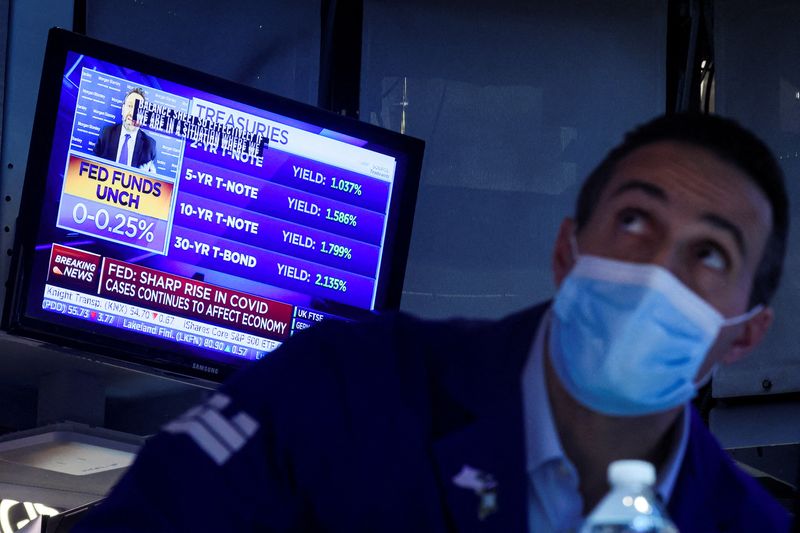By David Randall and Davide Barbuscia
NEW YORK (Reuters) - The Federal Reserve’s hawkish shift is bolstering the case for investors looking to trim risk from their portfolios, as the U.S. central bank trains its guns on surging inflation while giving little indication that it will be swayed by the latest weakness in stocks.
After the Fed's easy-money policies helped the S&P 500 soar from its March 2020 lows, investors must now contend with uncertainty on multiple fronts as the Fed gears up to raise interest rates and shrink its nearly $9 trillion balance sheet.
“I continue to believe you have to be really conservative in your portfolio today,” said Rick Rieder, BlackRock (NYSE:BLK)'s chief investment officer of global fixed income. “The Fed is going to have to see a few more cards on inflation and the economy, and the uncertainty is high.”
At the conclusion of its latest monetary policy meeting on Wednesday, the Fed said it is likely to hike rates in March and reaffirmed plans to end its bond purchases that month in what Fed chief Jerome Powell pledged will be a sustained battle to tame inflation, which by some measures is at its highest levels since 1982.
Fed funds futures, which track short-term rate expectations, are now pricing in a total of 4.4 rate increases this year, up from four expected hikes before Powell's press conference.
Markets had been jittery ahead of the meeting, with the S&P 500 down 8.6% for the year-to-date. That threatened to put the index on the path for its worst January performance in history, ahead of the 8.57% decline registered in January 2009, according to Ned Davis Research.
For some investors, the uncertainty means that January’s market swings could be a preview of how asset prices will behave in coming months – a stark contrast from the becalmed markets many had grown used to since the Fed unleashed its massive stimulus programs nearly two years ago.
In addition, questions over how the Fed will act appeared to have made investors more skittish about buying dips in the U.S. stock market, a strategy that proved lucrative over the last two years.
"The Fed has really been the backstop for the market and now the Fed is starting to give the market a lot more rope," said Andy Kapyrin, co-chief investment officer at wealth manager RegentAtlantic, who has been shifting more of his firm's assets into value stocks -- shares of economically sensitive companies that would benefit from rising rates and shortening durations in his bond portfolios.
RJ Gallo, senior portfolio manager at Federated Hermes (NYSE:FHI), believes the Fed will raise rates in 25 basis point increments for the remainder of the year starting at its March meeting. His firm has shortened the durations in its portfolios in anticipation that the yield of the 10-year Treasury bond will top 2% by the middle of the year, up from the current 1.77%.
"The Fed and inflation are going to be the dominant forces for markets for the entire year of 2022," Gallo said. “Nothing has suggested this year that inflation will unwind, and the only way they have to address it is rate hikes and to shrink the balance sheet."
Powell's remarks on Wednesday sent yields on U.S. Treasuries higher and flattened the yield curve. Some investors have been nervous about the potential for the Fed to tighten so aggressively that it risks a sharp growth slowdown and have been focusing on the flattening yield curve as a potential warning.
"I think what you end up with is more persistent volatility, which shouldn't be a surprise - that tends to happen at the dawn of tightening cycles - and a flatter yield curve," said Steve Bartolini, portfolio manager of T. Rowe Price’s New Income Fund, who said their portfolios were "relatively conservative to begin with."

Among the worst-hit assets in recent weeks have been tech stocks, with the Nasdaq Composite Index down 13.4% for the year. Cryptocurrencies have plunged, taking bitcoin down around 20% year-to-date.
“We have to be cautious with regards to positioning for risk assets,” said Brian Quigley, portfolio manager at Vanguard Fixed Income Group. “I would not be surprised to see more equity weakness, see more widening in spreads of corporate bonds.”